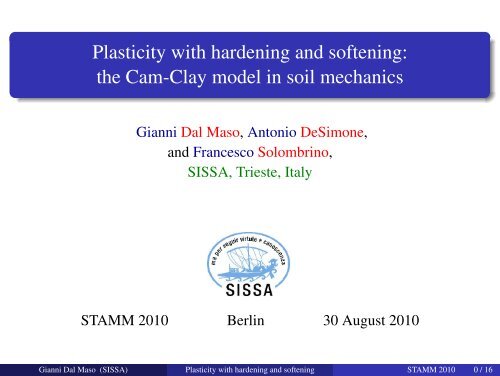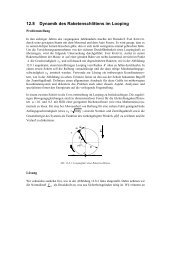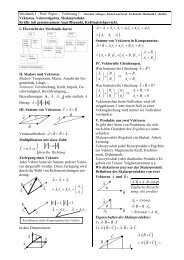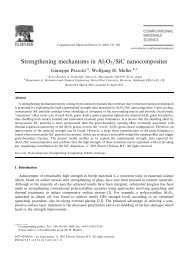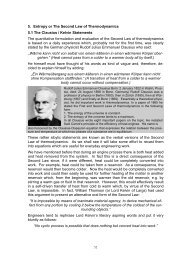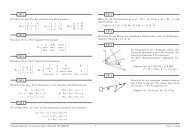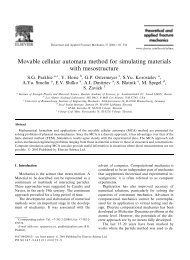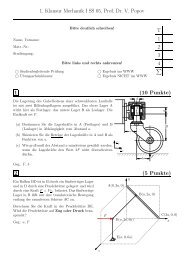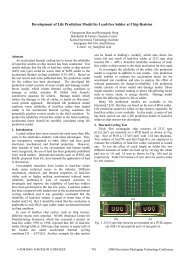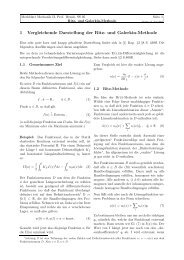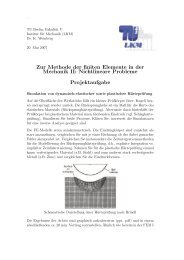the Cam-Clay model in soil mechanics
the Cam-Clay model in soil mechanics
the Cam-Clay model in soil mechanics
Create successful ePaper yourself
Turn your PDF publications into a flip-book with our unique Google optimized e-Paper software.
Plasticity with harden<strong>in</strong>g and soften<strong>in</strong>g:<br />
<strong>the</strong> <strong>Cam</strong>-<strong>Clay</strong> <strong>model</strong> <strong>in</strong> <strong>soil</strong> <strong>mechanics</strong><br />
Gianni Dal Maso, Antonio DeSimone,<br />
and Francesco Solombr<strong>in</strong>o,<br />
SISSA, Trieste, Italy<br />
STAMM 2010 Berl<strong>in</strong> 30 August 2010<br />
Gianni Dal Maso (SISSA) Plasticity with harden<strong>in</strong>g and soften<strong>in</strong>g STAMM 2010 0 / 16
<strong>Cam</strong>-<strong>Clay</strong> plasticity<br />
<strong>Cam</strong>-<strong>Clay</strong> plasticity is a phenomenological <strong>model</strong> used to describe <strong>the</strong><br />
<strong>in</strong>elastic behaviour of f<strong>in</strong>e gra<strong>in</strong>ed <strong>soil</strong>s. It exhibits both harden<strong>in</strong>g and<br />
soften<strong>in</strong>g, depend<strong>in</strong>g on <strong>the</strong> load<strong>in</strong>g conditions.<br />
The reference configuration is a bounded smooth open set Ω ⊂ R n . The<br />
variables and constra<strong>in</strong>ts of <strong>the</strong> <strong>model</strong> are:<br />
displacement: u: [0, +∞)×Ω → R n ,<br />
stra<strong>in</strong>: Eu = 1<br />
2 (∇u+∇uT ): [0, +∞)×Ω → M n×n<br />
sym ,<br />
additive decomposition: Eu = e + p ,<br />
elastic stra<strong>in</strong>: e: [0, +∞)×Ω → M n×n<br />
sym ,<br />
plastic stra<strong>in</strong>: p: [0, +∞)×Ω → M n×n<br />
sym ,<br />
stress: σ = 2 µ e + λ tr(e)I (µ,λ Lamé constants),<br />
<strong>in</strong>ternal variable: ζ: [0, +∞)×Ω → [1, +∞) ,<br />
stress constra<strong>in</strong>t: σ(t, x) ∈ K(ζ(t, x)) for every (t, x).<br />
Gianni Dal Maso (SISSA) Plasticity with harden<strong>in</strong>g and soften<strong>in</strong>g STAMM 2010 1 / 16
<strong>Cam</strong>-<strong>Clay</strong> plasticity<br />
<strong>Cam</strong>-<strong>Clay</strong> plasticity is a phenomenological <strong>model</strong> used to describe <strong>the</strong><br />
<strong>in</strong>elastic behaviour of f<strong>in</strong>e gra<strong>in</strong>ed <strong>soil</strong>s. It exhibits both harden<strong>in</strong>g and<br />
soften<strong>in</strong>g, depend<strong>in</strong>g on <strong>the</strong> load<strong>in</strong>g conditions.<br />
The reference configuration is a bounded smooth open set Ω ⊂ R n . The<br />
variables and constra<strong>in</strong>ts of <strong>the</strong> <strong>model</strong> are:<br />
displacement: u: [0, +∞)×Ω → R n ,<br />
stra<strong>in</strong>: Eu = 1<br />
2 (∇u+∇uT ): [0, +∞)×Ω → M n×n<br />
sym ,<br />
additive decomposition: Eu = e + p ,<br />
elastic stra<strong>in</strong>: e: [0, +∞)×Ω → M n×n<br />
sym ,<br />
plastic stra<strong>in</strong>: p: [0, +∞)×Ω → M n×n<br />
sym ,<br />
stress: σ = 2 µ e + λ tr(e)I (µ,λ Lamé constants),<br />
<strong>in</strong>ternal variable: ζ: [0, +∞)×Ω → [1, +∞) ,<br />
stress constra<strong>in</strong>t: σ(t, x) ∈ K(ζ(t, x)) for every (t, x).<br />
Gianni Dal Maso (SISSA) Plasticity with harden<strong>in</strong>g and soften<strong>in</strong>g STAMM 2010 1 / 16
<strong>Cam</strong>-<strong>Clay</strong> plasticity<br />
<strong>Cam</strong>-<strong>Clay</strong> plasticity is a phenomenological <strong>model</strong> used to describe <strong>the</strong><br />
<strong>in</strong>elastic behaviour of f<strong>in</strong>e gra<strong>in</strong>ed <strong>soil</strong>s. It exhibits both harden<strong>in</strong>g and<br />
soften<strong>in</strong>g, depend<strong>in</strong>g on <strong>the</strong> load<strong>in</strong>g conditions.<br />
The reference configuration is a bounded smooth open set Ω ⊂ R n . The<br />
variables and constra<strong>in</strong>ts of <strong>the</strong> <strong>model</strong> are:<br />
displacement: u: [0, +∞)×Ω → R n ,<br />
stra<strong>in</strong>: Eu = 1<br />
2 (∇u+∇uT ): [0, +∞)×Ω → M n×n<br />
sym ,<br />
additive decomposition: Eu = e + p ,<br />
elastic stra<strong>in</strong>: e: [0, +∞)×Ω → M n×n<br />
sym ,<br />
plastic stra<strong>in</strong>: p: [0, +∞)×Ω → M n×n<br />
sym ,<br />
stress: σ = 2 µ e + λ tr(e)I (µ,λ Lamé constants),<br />
<strong>in</strong>ternal variable: ζ: [0, +∞)×Ω → [1, +∞) ,<br />
stress constra<strong>in</strong>t: σ(t, x) ∈ K(ζ(t, x)) for every (t, x).<br />
Gianni Dal Maso (SISSA) Plasticity with harden<strong>in</strong>g and soften<strong>in</strong>g STAMM 2010 1 / 16
<strong>Cam</strong>-<strong>Clay</strong> plasticity<br />
<strong>Cam</strong>-<strong>Clay</strong> plasticity is a phenomenological <strong>model</strong> used to describe <strong>the</strong><br />
<strong>in</strong>elastic behaviour of f<strong>in</strong>e gra<strong>in</strong>ed <strong>soil</strong>s. It exhibits both harden<strong>in</strong>g and<br />
soften<strong>in</strong>g, depend<strong>in</strong>g on <strong>the</strong> load<strong>in</strong>g conditions.<br />
The reference configuration is a bounded smooth open set Ω ⊂ R n . The<br />
variables and constra<strong>in</strong>ts of <strong>the</strong> <strong>model</strong> are:<br />
displacement: u: [0, +∞)×Ω → R n ,<br />
stra<strong>in</strong>: Eu = 1<br />
2 (∇u+∇uT ): [0, +∞)×Ω → M n×n<br />
sym ,<br />
additive decomposition: Eu = e + p ,<br />
elastic stra<strong>in</strong>: e: [0, +∞)×Ω → M n×n<br />
sym ,<br />
plastic stra<strong>in</strong>: p: [0, +∞)×Ω → M n×n<br />
sym ,<br />
stress: σ = 2 µ e + λ tr(e)I (µ,λ Lamé constants),<br />
<strong>in</strong>ternal variable: ζ: [0, +∞)×Ω → [1, +∞) ,<br />
stress constra<strong>in</strong>t: σ(t, x) ∈ K(ζ(t, x)) for every (t, x).<br />
Gianni Dal Maso (SISSA) Plasticity with harden<strong>in</strong>g and soften<strong>in</strong>g STAMM 2010 1 / 16
<strong>Cam</strong>-<strong>Clay</strong> plasticity<br />
<strong>Cam</strong>-<strong>Clay</strong> plasticity is a phenomenological <strong>model</strong> used to describe <strong>the</strong><br />
<strong>in</strong>elastic behaviour of f<strong>in</strong>e gra<strong>in</strong>ed <strong>soil</strong>s. It exhibits both harden<strong>in</strong>g and<br />
soften<strong>in</strong>g, depend<strong>in</strong>g on <strong>the</strong> load<strong>in</strong>g conditions.<br />
The reference configuration is a bounded smooth open set Ω ⊂ R n . The<br />
variables and constra<strong>in</strong>ts of <strong>the</strong> <strong>model</strong> are:<br />
displacement: u: [0, +∞)×Ω → R n ,<br />
stra<strong>in</strong>: Eu = 1<br />
2 (∇u+∇uT ): [0, +∞)×Ω → M n×n<br />
sym ,<br />
additive decomposition: Eu = e + p ,<br />
elastic stra<strong>in</strong>: e: [0, +∞)×Ω → M n×n<br />
sym ,<br />
plastic stra<strong>in</strong>: p: [0, +∞)×Ω → M n×n<br />
sym ,<br />
stress: σ = 2 µ e + λ tr(e)I (µ,λ Lamé constants),<br />
<strong>in</strong>ternal variable: ζ: [0, +∞)×Ω → [1, +∞) ,<br />
stress constra<strong>in</strong>t: σ(t, x) ∈ K(ζ(t, x)) for every (t, x).<br />
Gianni Dal Maso (SISSA) Plasticity with harden<strong>in</strong>g and soften<strong>in</strong>g STAMM 2010 1 / 16
<strong>Cam</strong>-<strong>Clay</strong> plasticity<br />
<strong>Cam</strong>-<strong>Clay</strong> plasticity is a phenomenological <strong>model</strong> used to describe <strong>the</strong><br />
<strong>in</strong>elastic behaviour of f<strong>in</strong>e gra<strong>in</strong>ed <strong>soil</strong>s. It exhibits both harden<strong>in</strong>g and<br />
soften<strong>in</strong>g, depend<strong>in</strong>g on <strong>the</strong> load<strong>in</strong>g conditions.<br />
The reference configuration is a bounded smooth open set Ω ⊂ R n . The<br />
variables and constra<strong>in</strong>ts of <strong>the</strong> <strong>model</strong> are:<br />
displacement: u: [0, +∞)×Ω → R n ,<br />
stra<strong>in</strong>: Eu = 1<br />
2 (∇u+∇uT ): [0, +∞)×Ω → M n×n<br />
sym ,<br />
additive decomposition: Eu = e + p ,<br />
elastic stra<strong>in</strong>: e: [0, +∞)×Ω → M n×n<br />
sym ,<br />
plastic stra<strong>in</strong>: p: [0, +∞)×Ω → M n×n<br />
sym ,<br />
stress: σ = 2 µ e + λ tr(e)I (µ,λ Lamé constants),<br />
<strong>in</strong>ternal variable: ζ: [0, +∞)×Ω → [1, +∞) ,<br />
stress constra<strong>in</strong>t: σ(t, x) ∈ K(ζ(t, x)) for every (t, x).<br />
Gianni Dal Maso (SISSA) Plasticity with harden<strong>in</strong>g and soften<strong>in</strong>g STAMM 2010 1 / 16
The constra<strong>in</strong>t<br />
The sets ∂K(ζ) play <strong>the</strong> role of <strong>the</strong> yield surfaces. In <strong>the</strong> typical applications<br />
<strong>the</strong>y are homo<strong>the</strong>tic ellipsoids <strong>in</strong> Mn×n sym pass<strong>in</strong>g through <strong>the</strong> orig<strong>in</strong>. We<br />
assume only K(ζ) = ζK(1) for every ζ ≥ 1 (homo<strong>the</strong>ty condition), where<br />
K(1) is a compact convex subset of Mn×n sym with 0 ∈ <strong>in</strong>t K(1) (0 ∈ K(1) and<br />
K(1) with nonempty <strong>in</strong>terior is enough, with a slightly different proof). This<br />
implies<br />
1 ≤ ζ1 ≤ ζ2 =⇒ K(ζ1) ⊂ K(ζ2) .<br />
Therefore, if ˙ζ(t, x) > 0, <strong>the</strong> set K(ζ(t, x)) expands lead<strong>in</strong>g to a harden<strong>in</strong>g<br />
response. On <strong>the</strong> contrary, if ˙ζ(t, x) < 0, <strong>the</strong> set K(ζ(t, x))shr<strong>in</strong>ks lead<strong>in</strong>g to<br />
a soften<strong>in</strong>g response.<br />
Gianni Dal Maso (SISSA) Plasticity with harden<strong>in</strong>g and soften<strong>in</strong>g STAMM 2010 2 / 16
The constra<strong>in</strong>t<br />
The sets ∂K(ζ) play <strong>the</strong> role of <strong>the</strong> yield surfaces. In <strong>the</strong> typical applications<br />
<strong>the</strong>y are homo<strong>the</strong>tic ellipsoids <strong>in</strong> Mn×n sym pass<strong>in</strong>g through <strong>the</strong> orig<strong>in</strong>. We<br />
assume only K(ζ) = ζK(1) for every ζ ≥ 1 (homo<strong>the</strong>ty condition), where<br />
K(1) is a compact convex subset of Mn×n sym with 0 ∈ <strong>in</strong>t K(1) (0 ∈ K(1) and<br />
K(1) with nonempty <strong>in</strong>terior is enough, with a slightly different proof). This<br />
implies<br />
1 ≤ ζ1 ≤ ζ2 =⇒ K(ζ1) ⊂ K(ζ2) .<br />
Therefore, if ˙ζ(t, x) > 0, <strong>the</strong> set K(ζ(t, x)) expands lead<strong>in</strong>g to a harden<strong>in</strong>g<br />
response. On <strong>the</strong> contrary, if ˙ζ(t, x) < 0, <strong>the</strong> set K(ζ(t, x))shr<strong>in</strong>ks lead<strong>in</strong>g to<br />
a soften<strong>in</strong>g response.<br />
Gianni Dal Maso (SISSA) Plasticity with harden<strong>in</strong>g and soften<strong>in</strong>g STAMM 2010 2 / 16
The constra<strong>in</strong>t<br />
The sets ∂K(ζ) play <strong>the</strong> role of <strong>the</strong> yield surfaces. In <strong>the</strong> typical applications<br />
<strong>the</strong>y are homo<strong>the</strong>tic ellipsoids <strong>in</strong> Mn×n sym pass<strong>in</strong>g through <strong>the</strong> orig<strong>in</strong>. We<br />
assume only K(ζ) = ζK(1) for every ζ ≥ 1 (homo<strong>the</strong>ty condition), where<br />
K(1) is a compact convex subset of Mn×n sym with 0 ∈ <strong>in</strong>t K(1) (0 ∈ K(1) and<br />
K(1) with nonempty <strong>in</strong>terior is enough, with a slightly different proof). This<br />
implies<br />
1 ≤ ζ1 ≤ ζ2 =⇒ K(ζ1) ⊂ K(ζ2) .<br />
Therefore, if ˙ζ(t, x) > 0, <strong>the</strong> set K(ζ(t, x)) expands lead<strong>in</strong>g to a harden<strong>in</strong>g<br />
response. On <strong>the</strong> contrary, if ˙ζ(t, x) < 0, <strong>the</strong> set K(ζ(t, x))shr<strong>in</strong>ks lead<strong>in</strong>g to<br />
a soften<strong>in</strong>g response.<br />
Gianni Dal Maso (SISSA) Plasticity with harden<strong>in</strong>g and soften<strong>in</strong>g STAMM 2010 2 / 16
The evolution laws<br />
For simplicity of exposition, no applied forces, only prescribed boundary<br />
displacements w(t, x) (smooth and time dependent). The evolution law is<br />
expressed us<strong>in</strong>g a new <strong>in</strong>ternal variable z, related to ζ by ζ = V(z), where<br />
V : [0, +∞) → [1, +∞) is nondecreas<strong>in</strong>g and Lipschitz. The equations are:<br />
k<strong>in</strong>ematic admissibility<br />
Eu(t, x)=e(t, x)+p(t, x) on Ω, u(t, x)=w(t, x) on ∂Ω,<br />
constitutive equations<br />
σ(t, x) = 2 µ e(t, x) + λ tr(e(t, x))I, ζ(t, x) = V(z(t, x)),<br />
equilibrium condition<br />
divxσ(t, x) = 0 on Ω ,<br />
stress constra<strong>in</strong>t<br />
σ(t, x) ∈ K(ζ(t, x)) ,<br />
flow rule<br />
˙p(t, x) ∈ N K(ζ(t,x))(σ(t, x))= normal to K(ζ(t, x)) at σ(t, x).<br />
Gianni Dal Maso (SISSA) Plasticity with harden<strong>in</strong>g and soften<strong>in</strong>g STAMM 2010 3 / 16
The evolution laws<br />
For simplicity of exposition, no applied forces, only prescribed boundary<br />
displacements w(t, x) (smooth and time dependent). The evolution law is<br />
expressed us<strong>in</strong>g a new <strong>in</strong>ternal variable z, related to ζ by ζ = V(z), where<br />
V : [0, +∞) → [1, +∞) is nondecreas<strong>in</strong>g and Lipschitz. The equations are:<br />
k<strong>in</strong>ematic admissibility<br />
Eu(t, x)=e(t, x)+p(t, x) on Ω, u(t, x)=w(t, x) on ∂Ω,<br />
constitutive equations<br />
σ(t, x) = 2 µ e(t, x) + λ tr(e(t, x))I, ζ(t, x) = V(z(t, x)),<br />
equilibrium condition<br />
divxσ(t, x) = 0 on Ω ,<br />
stress constra<strong>in</strong>t<br />
σ(t, x) ∈ K(ζ(t, x)) ,<br />
flow rule<br />
˙p(t, x) ∈ N K(ζ(t,x))(σ(t, x))= normal to K(ζ(t, x)) at σ(t, x).<br />
Gianni Dal Maso (SISSA) Plasticity with harden<strong>in</strong>g and soften<strong>in</strong>g STAMM 2010 3 / 16
The evolution laws<br />
For simplicity of exposition, no applied forces, only prescribed boundary<br />
displacements w(t, x) (smooth and time dependent). The evolution law is<br />
expressed us<strong>in</strong>g a new <strong>in</strong>ternal variable z, related to ζ by ζ = V(z), where<br />
V : [0, +∞) → [1, +∞) is nondecreas<strong>in</strong>g and Lipschitz. The equations are:<br />
k<strong>in</strong>ematic admissibility<br />
Eu(t, x)=e(t, x)+p(t, x) on Ω, u(t, x)=w(t, x) on ∂Ω,<br />
constitutive equations<br />
σ(t, x) = 2 µ e(t, x) + λ tr(e(t, x))I, ζ(t, x) = V(z(t, x)),<br />
equilibrium condition<br />
divxσ(t, x) = 0 on Ω ,<br />
stress constra<strong>in</strong>t<br />
σ(t, x) ∈ K(ζ(t, x)) ,<br />
flow rule<br />
˙p(t, x) ∈ N K(ζ(t,x))(σ(t, x))= normal to K(ζ(t, x)) at σ(t, x).<br />
Gianni Dal Maso (SISSA) Plasticity with harden<strong>in</strong>g and soften<strong>in</strong>g STAMM 2010 3 / 16
The evolution laws<br />
For simplicity of exposition, no applied forces, only prescribed boundary<br />
displacements w(t, x) (smooth and time dependent). The evolution law is<br />
expressed us<strong>in</strong>g a new <strong>in</strong>ternal variable z, related to ζ by ζ = V(z), where<br />
V : [0, +∞) → [1, +∞) is nondecreas<strong>in</strong>g and Lipschitz. The equations are:<br />
k<strong>in</strong>ematic admissibility<br />
Eu(t, x)=e(t, x)+p(t, x) on Ω, u(t, x)=w(t, x) on ∂Ω,<br />
constitutive equations<br />
σ(t, x) = 2 µ e(t, x) + λ tr(e(t, x))I, ζ(t, x) = V(z(t, x)),<br />
equilibrium condition<br />
divxσ(t, x) = 0 on Ω ,<br />
stress constra<strong>in</strong>t<br />
σ(t, x) ∈ K(ζ(t, x)) ,<br />
flow rule<br />
˙p(t, x) ∈ N K(ζ(t,x))(σ(t, x))= normal to K(ζ(t, x)) at σ(t, x).<br />
Gianni Dal Maso (SISSA) Plasticity with harden<strong>in</strong>g and soften<strong>in</strong>g STAMM 2010 3 / 16
The evolution laws<br />
For simplicity of exposition, no applied forces, only prescribed boundary<br />
displacements w(t, x) (smooth and time dependent). The evolution law is<br />
expressed us<strong>in</strong>g a new <strong>in</strong>ternal variable z, related to ζ by ζ = V(z), where<br />
V : [0, +∞) → [1, +∞) is nondecreas<strong>in</strong>g and Lipschitz. The equations are:<br />
k<strong>in</strong>ematic admissibility<br />
Eu(t, x)=e(t, x)+p(t, x) on Ω, u(t, x)=w(t, x) on ∂Ω,<br />
constitutive equations<br />
σ(t, x) = 2 µ e(t, x) + λ tr(e(t, x))I, ζ(t, x) = V(z(t, x)),<br />
equilibrium condition<br />
divxσ(t, x) = 0 on Ω ,<br />
stress constra<strong>in</strong>t<br />
σ(t, x) ∈ K(ζ(t, x)) ,<br />
flow rule<br />
˙p(t, x) ∈ N K(ζ(t,x))(σ(t, x))= normal to K(ζ(t, x)) at σ(t, x).<br />
Gianni Dal Maso (SISSA) Plasticity with harden<strong>in</strong>g and soften<strong>in</strong>g STAMM 2010 3 / 16
The evolution laws<br />
For simplicity of exposition, no applied forces, only prescribed boundary<br />
displacements w(t, x) (smooth and time dependent). The evolution law is<br />
expressed us<strong>in</strong>g a new <strong>in</strong>ternal variable z, related to ζ by ζ = V(z), where<br />
V : [0, +∞) → [1, +∞) is nondecreas<strong>in</strong>g and Lipschitz. The equations are:<br />
k<strong>in</strong>ematic admissibility<br />
Eu(t, x)=e(t, x)+p(t, x) on Ω, u(t, x)=w(t, x) on ∂Ω,<br />
constitutive equations<br />
σ(t, x) = 2 µ e(t, x) + λ tr(e(t, x))I, ζ(t, x) = V(z(t, x)),<br />
equilibrium condition<br />
divxσ(t, x) = 0 on Ω ,<br />
stress constra<strong>in</strong>t<br />
σ(t, x) ∈ K(ζ(t, x)) ,<br />
flow rule<br />
˙p(t, x) ∈ N K(ζ(t,x))(σ(t, x))= normal to K(ζ(t, x)) at σ(t, x).<br />
Gianni Dal Maso (SISSA) Plasticity with harden<strong>in</strong>g and soften<strong>in</strong>g STAMM 2010 3 / 16
The evolution law for <strong>the</strong> <strong>in</strong>ternal variable<br />
Usually <strong>the</strong> nonassociative evolution law for <strong>the</strong> <strong>in</strong>ternal variable z is<br />
˙z(t, x) = tr σ(t, x) tr ˙p(t, x) ,<br />
and tr σ ≤ 0 for every σ ∈ K(ζ) (compressive condition of <strong>soil</strong> <strong>mechanics</strong>),<br />
so that <strong>the</strong> harden<strong>in</strong>g or soften<strong>in</strong>g behaviour is determ<strong>in</strong>ed only by <strong>the</strong> sign of<br />
tr ˙p.<br />
We consider here <strong>the</strong> nonlocal variant<br />
˙z(t, x) = ρ ⋆ [(ρ ⋆ tr σ(t, ·)) tr ˙p(t, ·)](x) ,<br />
where ⋆ denotes <strong>the</strong> convolution with respect to <strong>the</strong> space variable x, and ρ<br />
is a smooth convolution kernel.<br />
The convolution ensures that a very weak convergence of σ and ˙p implies<br />
strong convergence of <strong>the</strong> correspond<strong>in</strong>g z. It gives a nonlocal character to<br />
<strong>the</strong> evolution: <strong>the</strong> size of <strong>the</strong> yield surface at a po<strong>in</strong>t x is affected by tr σ and<br />
tr ˙p <strong>in</strong> a small neighborhod of x, which is not physically implausible.<br />
Gianni Dal Maso (SISSA) Plasticity with harden<strong>in</strong>g and soften<strong>in</strong>g STAMM 2010 4 / 16
The evolution law for <strong>the</strong> <strong>in</strong>ternal variable<br />
Usually <strong>the</strong> nonassociative evolution law for <strong>the</strong> <strong>in</strong>ternal variable z is<br />
˙z(t, x) = tr σ(t, x) tr ˙p(t, x) ,<br />
and tr σ ≤ 0 for every σ ∈ K(ζ) (compressive condition of <strong>soil</strong> <strong>mechanics</strong>),<br />
so that <strong>the</strong> harden<strong>in</strong>g or soften<strong>in</strong>g behaviour is determ<strong>in</strong>ed only by <strong>the</strong> sign of<br />
tr ˙p.<br />
We consider here <strong>the</strong> nonlocal variant<br />
˙z(t, x) = ρ ⋆ [(ρ ⋆ tr σ(t, ·)) tr ˙p(t, ·)](x) ,<br />
where ⋆ denotes <strong>the</strong> convolution with respect to <strong>the</strong> space variable x, and ρ<br />
is a smooth convolution kernel.<br />
The convolution ensures that a very weak convergence of σ and ˙p implies<br />
strong convergence of <strong>the</strong> correspond<strong>in</strong>g z. It gives a nonlocal character to<br />
<strong>the</strong> evolution: <strong>the</strong> size of <strong>the</strong> yield surface at a po<strong>in</strong>t x is affected by tr σ and<br />
tr ˙p <strong>in</strong> a small neighborhod of x, which is not physically implausible.<br />
Gianni Dal Maso (SISSA) Plasticity with harden<strong>in</strong>g and soften<strong>in</strong>g STAMM 2010 4 / 16
The evolution law for <strong>the</strong> <strong>in</strong>ternal variable<br />
Usually <strong>the</strong> nonassociative evolution law for <strong>the</strong> <strong>in</strong>ternal variable z is<br />
˙z(t, x) = tr σ(t, x) tr ˙p(t, x) ,<br />
and tr σ ≤ 0 for every σ ∈ K(ζ) (compressive condition of <strong>soil</strong> <strong>mechanics</strong>),<br />
so that <strong>the</strong> harden<strong>in</strong>g or soften<strong>in</strong>g behaviour is determ<strong>in</strong>ed only by <strong>the</strong> sign of<br />
tr ˙p.<br />
We consider here <strong>the</strong> nonlocal variant<br />
˙z(t, x) = ρ ⋆ [(ρ ⋆ tr σ(t, ·)) tr ˙p(t, ·)](x) ,<br />
where ⋆ denotes <strong>the</strong> convolution with respect to <strong>the</strong> space variable x, and ρ<br />
is a smooth convolution kernel.<br />
The convolution ensures that a very weak convergence of σ and ˙p implies<br />
strong convergence of <strong>the</strong> correspond<strong>in</strong>g z. It gives a nonlocal character to<br />
<strong>the</strong> evolution: <strong>the</strong> size of <strong>the</strong> yield surface at a po<strong>in</strong>t x is affected by tr σ and<br />
tr ˙p <strong>in</strong> a small neighborhod of x, which is not physically implausible.<br />
Gianni Dal Maso (SISSA) Plasticity with harden<strong>in</strong>g and soften<strong>in</strong>g STAMM 2010 4 / 16
A f<strong>in</strong>ite dimensional example<br />
Ew(t, x) = − 2 1<br />
nI + t<br />
tr eD = 0, K(ζ) = {σ ∈ Mn×n x, y<br />
15<br />
10<br />
5<br />
0<br />
z0 3.81<br />
z0 3.81<br />
z0 6.54<br />
z0 6.54<br />
t0 3.35<br />
z0 9.77<br />
t0 4.71<br />
z0 13.48<br />
√ n eD , σ(t) = e(t) = −x(t) 1<br />
sym : |σ + 1<br />
n<br />
n<br />
ζI| ≤ 1<br />
√ n ζ} .<br />
5 10 15 20<br />
t0 5.92<br />
z0 17.72<br />
t0 7.07<br />
z0 22.5<br />
z0 9.77<br />
z0 13.48<br />
z0 17.72<br />
z0 22.5<br />
z0 27.83<br />
z0 33.71<br />
t0 8.18<br />
z0 27.83<br />
t1 8.69<br />
t0 9.27<br />
z0 33.71 z<br />
t0 10.36<br />
t1 10.38<br />
t0 11.44<br />
t1 12.17<br />
t1 14.09<br />
t1 16.09<br />
z 7.45<br />
z 6.75<br />
z 6.07<br />
z 5.35<br />
z 4.65<br />
z 3.95<br />
z 3.25<br />
2.55<br />
I + y(t) 1<br />
√ n eD ,<br />
t<br />
Dashed l<strong>in</strong>es: x(t).<br />
Solid l<strong>in</strong>es: y(t).<br />
Gianni Dal Maso (SISSA) Plasticity with harden<strong>in</strong>g and soften<strong>in</strong>g STAMM 2010 5 / 16
Viscoplastic approximation<br />
We <strong>in</strong>troduce a notion of generalized solution, based on a viscoplastic<br />
approximation of Perzyna-type. Given a viscosity parameter ε > 0, <strong>the</strong><br />
equations are:<br />
k<strong>in</strong>ematic admissibility<br />
Euε(t,x)=eε(t,x)+pε(t,x) on Ω, uε(t,x)=w(t,x) on ∂Ω,<br />
constitutive equations<br />
σε(t,x) = 2µeε(t,x)+λ tr(eε(t,x))I, ζε(t,x) = V(zε(t,x)),<br />
equilibrium condition<br />
divxσε(t, x) = 0 ,<br />
regularized flow rule (no stress constra<strong>in</strong>t)<br />
˙pε(t, x) = Nε K(ζε(t,x)) (σε(t, x)), where Nε <br />
1<br />
K(ζ) (σ) := ε<br />
σ−πK(ζ)(σ) ,<br />
πK(ζ) projection onto K(ζ).<br />
evolution law for <strong>the</strong> <strong>in</strong>ternal variable<br />
˙zε(t, x) = ρ ⋆ [(ρ ⋆ tr σε(t, ·)) tr ˙pε(t, ·)](x) .<br />
Gianni Dal Maso (SISSA) Plasticity with harden<strong>in</strong>g and soften<strong>in</strong>g STAMM 2010 6 / 16
Viscoplastic approximation<br />
We <strong>in</strong>troduce a notion of generalized solution, based on a viscoplastic<br />
approximation of Perzyna-type. Given a viscosity parameter ε > 0, <strong>the</strong><br />
equations are:<br />
k<strong>in</strong>ematic admissibility<br />
Euε(t,x)=eε(t,x)+pε(t,x) on Ω, uε(t,x)=w(t,x) on ∂Ω,<br />
constitutive equations<br />
σε(t,x) = 2µeε(t,x)+λ tr(eε(t,x))I, ζε(t,x) = V(zε(t,x)),<br />
equilibrium condition<br />
divxσε(t, x) = 0 ,<br />
regularized flow rule (no stress constra<strong>in</strong>t)<br />
˙pε(t, x) = Nε K(ζε(t,x)) (σε(t, x)), where Nε <br />
1<br />
K(ζ) (σ) := ε<br />
σ−πK(ζ)(σ) ,<br />
πK(ζ) projection onto K(ζ).<br />
evolution law for <strong>the</strong> <strong>in</strong>ternal variable<br />
˙zε(t, x) = ρ ⋆ [(ρ ⋆ tr σε(t, ·)) tr ˙pε(t, ·)](x) .<br />
Gianni Dal Maso (SISSA) Plasticity with harden<strong>in</strong>g and soften<strong>in</strong>g STAMM 2010 6 / 16
Viscoplastic approximation<br />
We <strong>in</strong>troduce a notion of generalized solution, based on a viscoplastic<br />
approximation of Perzyna-type. Given a viscosity parameter ε > 0, <strong>the</strong><br />
equations are:<br />
k<strong>in</strong>ematic admissibility<br />
Euε(t,x)=eε(t,x)+pε(t,x) on Ω, uε(t,x)=w(t,x) on ∂Ω,<br />
constitutive equations<br />
σε(t,x) = 2µeε(t,x)+λ tr(eε(t,x))I, ζε(t,x) = V(zε(t,x)),<br />
equilibrium condition<br />
divxσε(t, x) = 0 ,<br />
regularized flow rule (no stress constra<strong>in</strong>t)<br />
˙pε(t, x) = Nε K(ζε(t,x)) (σε(t, x)), where Nε <br />
1<br />
K(ζ) (σ) := ε<br />
σ−πK(ζ)(σ) ,<br />
πK(ζ) projection onto K(ζ).<br />
evolution law for <strong>the</strong> <strong>in</strong>ternal variable<br />
˙zε(t, x) = ρ ⋆ [(ρ ⋆ tr σε(t, ·)) tr ˙pε(t, ·)](x) .<br />
Gianni Dal Maso (SISSA) Plasticity with harden<strong>in</strong>g and soften<strong>in</strong>g STAMM 2010 6 / 16
Existence of <strong>the</strong> viscoplastic approximation<br />
If we fix ζε <strong>in</strong> a suitable function space, <strong>the</strong> existence of uε , eε , pε , and σε<br />
satisfy<strong>in</strong>g <strong>the</strong> first four equations and a prescribed <strong>in</strong>itial condition can be<br />
obta<strong>in</strong>ed by adapt<strong>in</strong>g a result by Suquet. To fulfill also <strong>the</strong> evolution law for<br />
<strong>the</strong> <strong>in</strong>ternal variable we use <strong>the</strong> Schauder fixed po<strong>in</strong>t <strong>the</strong>orem.<br />
To obta<strong>in</strong> an estimate of <strong>the</strong> viscoplastic approximation we <strong>in</strong>troduce <strong>the</strong><br />
follow<strong>in</strong>g functions:<br />
Stored elastic energy: Q(e(t)) := 1<br />
<br />
σ(t, x) : e(t, x) dx .<br />
2 Ω<br />
Support function of K(ζ): H(ξ, ζ) := sup{σ : ξ | σ ∈ K(ζ)}.<br />
<br />
Rate of plastic dissipation: H( ˙p(t), ζ(t)) : = H( ˙p(t, x), ζ(t, x)) dx .<br />
S<strong>in</strong>ce H(·, ζ) is positively homogeneous of degee one, <strong>the</strong> last def<strong>in</strong>ition can<br />
be extended when ˙p(t) is a measure on Ω and ζ(t, ·) is cont<strong>in</strong>uous.<br />
If <strong>the</strong> k<strong>in</strong>ematic admissiblity, <strong>the</strong> constitutive equations, and <strong>the</strong> equilibrium<br />
conditions are satisfied, <strong>the</strong>n <strong>the</strong> regularized flow rule implies<br />
Gianni Dal Maso (SISSA) Plasticity with harden<strong>in</strong>g and soften<strong>in</strong>g STAMM 2010 7 / 16<br />
Ω
Existence of <strong>the</strong> viscoplastic approximation<br />
If we fix ζε <strong>in</strong> a suitable function space, <strong>the</strong> existence of uε , eε , pε , and σε<br />
satisfy<strong>in</strong>g <strong>the</strong> first four equations and a prescribed <strong>in</strong>itial condition can be<br />
obta<strong>in</strong>ed by adapt<strong>in</strong>g a result by Suquet. To fulfill also <strong>the</strong> evolution law for<br />
<strong>the</strong> <strong>in</strong>ternal variable we use <strong>the</strong> Schauder fixed po<strong>in</strong>t <strong>the</strong>orem.<br />
To obta<strong>in</strong> an estimate of <strong>the</strong> viscoplastic approximation we <strong>in</strong>troduce <strong>the</strong><br />
follow<strong>in</strong>g functions:<br />
Stored elastic energy: Q(e(t)) := 1<br />
<br />
σ(t, x) : e(t, x) dx .<br />
2 Ω<br />
Support function of K(ζ): H(ξ, ζ) := sup{σ : ξ | σ ∈ K(ζ)}.<br />
<br />
Rate of plastic dissipation: H( ˙p(t), ζ(t)) : = H( ˙p(t, x), ζ(t, x)) dx .<br />
S<strong>in</strong>ce H(·, ζ) is positively homogeneous of degee one, <strong>the</strong> last def<strong>in</strong>ition can<br />
be extended when ˙p(t) is a measure on Ω and ζ(t, ·) is cont<strong>in</strong>uous.<br />
If <strong>the</strong> k<strong>in</strong>ematic admissiblity, <strong>the</strong> constitutive equations, and <strong>the</strong> equilibrium<br />
conditions are satisfied, <strong>the</strong>n <strong>the</strong> regularized flow rule implies<br />
Gianni Dal Maso (SISSA) Plasticity with harden<strong>in</strong>g and soften<strong>in</strong>g STAMM 2010 7 / 16<br />
Ω
Existence of <strong>the</strong> viscoplastic approximation<br />
If we fix ζε <strong>in</strong> a suitable function space, <strong>the</strong> existence of uε , eε , pε , and σε<br />
satisfy<strong>in</strong>g <strong>the</strong> first four equations and a prescribed <strong>in</strong>itial condition can be<br />
obta<strong>in</strong>ed by adapt<strong>in</strong>g a result by Suquet. To fulfill also <strong>the</strong> evolution law for<br />
<strong>the</strong> <strong>in</strong>ternal variable we use <strong>the</strong> Schauder fixed po<strong>in</strong>t <strong>the</strong>orem.<br />
To obta<strong>in</strong> an estimate of <strong>the</strong> viscoplastic approximation we <strong>in</strong>troduce <strong>the</strong><br />
follow<strong>in</strong>g functions:<br />
Stored elastic energy: Q(e(t)) := 1<br />
<br />
σ(t, x) : e(t, x) dx .<br />
2 Ω<br />
Support function of K(ζ): H(ξ, ζ) := sup{σ : ξ | σ ∈ K(ζ)}.<br />
<br />
Rate of plastic dissipation: H( ˙p(t), ζ(t)) : = H( ˙p(t, x), ζ(t, x)) dx .<br />
S<strong>in</strong>ce H(·, ζ) is positively homogeneous of degee one, <strong>the</strong> last def<strong>in</strong>ition can<br />
be extended when ˙p(t) is a measure on Ω and ζ(t, ·) is cont<strong>in</strong>uous.<br />
If <strong>the</strong> k<strong>in</strong>ematic admissiblity, <strong>the</strong> constitutive equations, and <strong>the</strong> equilibrium<br />
conditions are satisfied, <strong>the</strong>n <strong>the</strong> regularized flow rule implies<br />
Gianni Dal Maso (SISSA) Plasticity with harden<strong>in</strong>g and soften<strong>in</strong>g STAMM 2010 7 / 16<br />
Ω
Existence of <strong>the</strong> viscoplastic approximation<br />
If we fix ζε <strong>in</strong> a suitable function space, <strong>the</strong> existence of uε , eε , pε , and σε<br />
satisfy<strong>in</strong>g <strong>the</strong> first four equations and a prescribed <strong>in</strong>itial condition can be<br />
obta<strong>in</strong>ed by adapt<strong>in</strong>g a result by Suquet. To fulfill also <strong>the</strong> evolution law for<br />
<strong>the</strong> <strong>in</strong>ternal variable we use <strong>the</strong> Schauder fixed po<strong>in</strong>t <strong>the</strong>orem.<br />
To obta<strong>in</strong> an estimate of <strong>the</strong> viscoplastic approximation we <strong>in</strong>troduce <strong>the</strong><br />
follow<strong>in</strong>g functions:<br />
Stored elastic energy: Q(e(t)) := 1<br />
<br />
σ(t, x) : e(t, x) dx .<br />
2 Ω<br />
Support function of K(ζ): H(ξ, ζ) := sup{σ : ξ | σ ∈ K(ζ)}.<br />
<br />
Rate of plastic dissipation: H( ˙p(t), ζ(t)) : = H( ˙p(t, x), ζ(t, x)) dx .<br />
S<strong>in</strong>ce H(·, ζ) is positively homogeneous of degee one, <strong>the</strong> last def<strong>in</strong>ition can<br />
be extended when ˙p(t) is a measure on Ω and ζ(t, ·) is cont<strong>in</strong>uous.<br />
If <strong>the</strong> k<strong>in</strong>ematic admissiblity, <strong>the</strong> constitutive equations, and <strong>the</strong> equilibrium<br />
conditions are satisfied, <strong>the</strong>n <strong>the</strong> regularized flow rule implies<br />
Gianni Dal Maso (SISSA) Plasticity with harden<strong>in</strong>g and soften<strong>in</strong>g STAMM 2010 7 / 16<br />
Ω
Existence of <strong>the</strong> viscoplastic approximation<br />
If we fix ζε <strong>in</strong> a suitable function space, <strong>the</strong> existence of uε , eε , pε , and σε<br />
satisfy<strong>in</strong>g <strong>the</strong> first four equations and a prescribed <strong>in</strong>itial condition can be<br />
obta<strong>in</strong>ed by adapt<strong>in</strong>g a result by Suquet. To fulfill also <strong>the</strong> evolution law for<br />
<strong>the</strong> <strong>in</strong>ternal variable we use <strong>the</strong> Schauder fixed po<strong>in</strong>t <strong>the</strong>orem.<br />
To obta<strong>in</strong> an estimate of <strong>the</strong> viscoplastic approximation we <strong>in</strong>troduce <strong>the</strong><br />
follow<strong>in</strong>g functions:<br />
Stored elastic energy: Q(e(t)) := 1<br />
<br />
σ(t, x) : e(t, x) dx .<br />
2 Ω<br />
Support function of K(ζ): H(ξ, ζ) := sup{σ : ξ | σ ∈ K(ζ)}.<br />
<br />
Rate of plastic dissipation: H( ˙p(t), ζ(t)) : = H( ˙p(t, x), ζ(t, x)) dx .<br />
S<strong>in</strong>ce H(·, ζ) is positively homogeneous of degee one, <strong>the</strong> last def<strong>in</strong>ition can<br />
be extended when ˙p(t) is a measure on Ω and ζ(t, ·) is cont<strong>in</strong>uous.<br />
If <strong>the</strong> k<strong>in</strong>ematic admissiblity, <strong>the</strong> constitutive equations, and <strong>the</strong> equilibrium<br />
conditions are satisfied, <strong>the</strong>n <strong>the</strong> regularized flow rule implies<br />
Gianni Dal Maso (SISSA) Plasticity with harden<strong>in</strong>g and soften<strong>in</strong>g STAMM 2010 7 / 16<br />
Ω
Existence of <strong>the</strong> viscoplastic approximation<br />
If we fix ζε <strong>in</strong> a suitable function space, <strong>the</strong> existence of uε , eε , pε , and σε<br />
satisfy<strong>in</strong>g <strong>the</strong> first four equations and a prescribed <strong>in</strong>itial condition can be<br />
obta<strong>in</strong>ed by adapt<strong>in</strong>g a result by Suquet. To fulfill also <strong>the</strong> evolution law for<br />
<strong>the</strong> <strong>in</strong>ternal variable we use <strong>the</strong> Schauder fixed po<strong>in</strong>t <strong>the</strong>orem.<br />
To obta<strong>in</strong> an estimate of <strong>the</strong> viscoplastic approximation we <strong>in</strong>troduce <strong>the</strong><br />
follow<strong>in</strong>g functions:<br />
Stored elastic energy: Q(e(t)) := 1<br />
<br />
σ(t, x) : e(t, x) dx .<br />
2 Ω<br />
Support function of K(ζ): H(ξ, ζ) := sup{σ : ξ | σ ∈ K(ζ)}.<br />
<br />
Rate of plastic dissipation: H( ˙p(t), ζ(t)) : = H( ˙p(t, x), ζ(t, x)) dx .<br />
S<strong>in</strong>ce H(·, ζ) is positively homogeneous of degee one, <strong>the</strong> last def<strong>in</strong>ition can<br />
be extended when ˙p(t) is a measure on Ω and ζ(t, ·) is cont<strong>in</strong>uous.<br />
If <strong>the</strong> k<strong>in</strong>ematic admissiblity, <strong>the</strong> constitutive equations, and <strong>the</strong> equilibrium<br />
conditions are satisfied, <strong>the</strong>n <strong>the</strong> regularized flow rule implies<br />
Gianni Dal Maso (SISSA) Plasticity with harden<strong>in</strong>g and soften<strong>in</strong>g STAMM 2010 7 / 16<br />
Ω
Existence of <strong>the</strong> viscoplastic approximation<br />
If we fix ζε <strong>in</strong> a suitable function space, <strong>the</strong> existence of uε , eε , pε , and σε<br />
satisfy<strong>in</strong>g <strong>the</strong> first four equations and a prescribed <strong>in</strong>itial condition can be<br />
obta<strong>in</strong>ed by adapt<strong>in</strong>g a result by Suquet. To fulfill also <strong>the</strong> evolution law for<br />
<strong>the</strong> <strong>in</strong>ternal variable we use <strong>the</strong> Schauder fixed po<strong>in</strong>t <strong>the</strong>orem.<br />
To obta<strong>in</strong> an estimate of <strong>the</strong> viscoplastic approximation we <strong>in</strong>troduce <strong>the</strong><br />
follow<strong>in</strong>g functions:<br />
Stored elastic energy: Q(e(t)) := 1<br />
<br />
σ(t, x) : e(t, x) dx .<br />
2 Ω<br />
Support function of K(ζ): H(ξ, ζ) := sup{σ : ξ | σ ∈ K(ζ)}.<br />
<br />
Rate of plastic dissipation: H( ˙p(t), ζ(t)) : = H( ˙p(t, x), ζ(t, x)) dx .<br />
S<strong>in</strong>ce H(·, ζ) is positively homogeneous of degee one, <strong>the</strong> last def<strong>in</strong>ition can<br />
be extended when ˙p(t) is a measure on Ω and ζ(t, ·) is cont<strong>in</strong>uous.<br />
If <strong>the</strong> k<strong>in</strong>ematic admissiblity, <strong>the</strong> constitutive equations, and <strong>the</strong> equilibrium<br />
conditions are satisfied, <strong>the</strong>n <strong>the</strong> regularized flow rule implies<br />
Gianni Dal Maso (SISSA) Plasticity with harden<strong>in</strong>g and soften<strong>in</strong>g STAMM 2010 7 / 16<br />
Ω
Equivalent formulation and estimates<br />
modified stress constra<strong>in</strong>t: for a.e. t > 0 and a.e. x ∈ Ω<br />
σε(t, x) − ε ˙pε(t, x) ∈ K(ζε(t, x)) ,<br />
energy-dissipation balance: for every T > 0<br />
T<br />
Q(eε(T)) + H( ˙pε(t), ζε(t))dt+<br />
0<br />
T<br />
<br />
+ ˙pε(t)2 d2 σε(t), K(ζε(t))<br />
0<br />
dt =<br />
= Q(eε(0)) +<br />
T<br />
where d2 denotes <strong>the</strong> distance <strong>in</strong> L 2 .<br />
0<br />
〈σε(t), E ˙w(t)〉 dt ,<br />
This implies that for every T > 0 <strong>the</strong>re exists CT such that<br />
σε(t)2 ≤ CT and<br />
for every ε > 0 and every t ∈ [0, T].<br />
T<br />
0<br />
˙pε(t)1dt ≤ CT<br />
Gianni Dal Maso (SISSA) Plasticity with harden<strong>in</strong>g and soften<strong>in</strong>g STAMM 2010 8 / 16
Equivalent formulation and estimates<br />
modified stress constra<strong>in</strong>t: for a.e. t > 0 and a.e. x ∈ Ω<br />
σε(t, x) − ε ˙pε(t, x) ∈ K(ζε(t, x)) ,<br />
energy-dissipation balance: for every T > 0<br />
T<br />
Q(eε(T)) + H( ˙pε(t), ζε(t))dt+<br />
0<br />
T<br />
<br />
+ ˙pε(t)2 d2 σε(t), K(ζε(t))<br />
0<br />
dt =<br />
= Q(eε(0)) +<br />
T<br />
where d2 denotes <strong>the</strong> distance <strong>in</strong> L 2 .<br />
0<br />
〈σε(t), E ˙w(t)〉 dt ,<br />
This implies that for every T > 0 <strong>the</strong>re exists CT such that<br />
σε(t)2 ≤ CT and<br />
for every ε > 0 and every t ∈ [0, T].<br />
T<br />
0<br />
˙pε(t)1dt ≤ CT<br />
Gianni Dal Maso (SISSA) Plasticity with harden<strong>in</strong>g and soften<strong>in</strong>g STAMM 2010 8 / 16
Equivalent formulation and estimates<br />
modified stress constra<strong>in</strong>t: for a.e. t > 0 and a.e. x ∈ Ω<br />
σε(t, x) − ε ˙pε(t, x) ∈ K(ζε(t, x)) ,<br />
energy-dissipation balance: for every T > 0<br />
T<br />
Q(eε(T)) + H( ˙pε(t), ζε(t))dt+<br />
0<br />
T<br />
<br />
+ ˙pε(t)2 d2 σε(t), K(ζε(t))<br />
0<br />
dt =<br />
= Q(eε(0)) +<br />
T<br />
where d2 denotes <strong>the</strong> distance <strong>in</strong> L 2 .<br />
0<br />
〈σε(t), E ˙w(t)〉 dt ,<br />
This implies that for every T > 0 <strong>the</strong>re exists CT such that<br />
σε(t)2 ≤ CT and<br />
for every ε > 0 and every t ∈ [0, T].<br />
T<br />
0<br />
˙pε(t)1dt ≤ CT<br />
Gianni Dal Maso (SISSA) Plasticity with harden<strong>in</strong>g and soften<strong>in</strong>g STAMM 2010 8 / 16
Rescal<strong>in</strong>g<br />
We will rescale <strong>the</strong> solution us<strong>in</strong>g <strong>the</strong> function<br />
s ◦ ε(t) :=<br />
t<br />
0<br />
( ˙pε(τ)1 + E ˙w(τ)2 + 1) dτ ,<br />
and its <strong>in</strong>verse t ◦ ε := (s ◦ ε) −1 . The new variable s, called rescaled time, and<br />
<strong>the</strong> orig<strong>in</strong>al time t are related by s = s ◦ ε(t) and t = t ◦ ε(s). Def<strong>in</strong>e <strong>the</strong><br />
rescaled functions by w ◦ ε(s) := w(t ◦ ε(s)) , u ◦ ε(s) := uε(t ◦ ε(s)) ,<br />
,. . . ,ζ ◦ ε(s) := ζε(t ◦ ε(s)) . It follows that 0 < t ◦ ε(s2) − t ◦ ε(s1) ≤ s2 − s1 for<br />
every s1 < s2 . By <strong>the</strong> Arzelà-Ascoli Theorem we may assume that t ◦ ε<br />
converges uniformly on compact sets to a nondecreas<strong>in</strong>g Lipschitz function<br />
t ◦ : [0, +∞) → [0, +∞). In <strong>the</strong> limit <strong>the</strong> rescaled time s and <strong>the</strong> orig<strong>in</strong>al time<br />
t are related by t = t ◦ (s), which is, <strong>in</strong> general, not <strong>in</strong>vertible.<br />
From <strong>the</strong> def<strong>in</strong>itions of s ◦ ε and t ◦ ε we obta<strong>in</strong> easily that<br />
p ◦ ε(s2) − p ◦ ε(s1)1 ≤ |s2 − s1|.<br />
Gianni Dal Maso (SISSA) Plasticity with harden<strong>in</strong>g and soften<strong>in</strong>g STAMM 2010 9 / 16
Rescal<strong>in</strong>g<br />
We will rescale <strong>the</strong> solution us<strong>in</strong>g <strong>the</strong> function<br />
s ◦ ε(t) :=<br />
t<br />
0<br />
( ˙pε(τ)1 + E ˙w(τ)2 + 1) dτ ,<br />
and its <strong>in</strong>verse t ◦ ε := (s ◦ ε) −1 . The new variable s, called rescaled time, and<br />
<strong>the</strong> orig<strong>in</strong>al time t are related by s = s ◦ ε(t) and t = t ◦ ε(s). Def<strong>in</strong>e <strong>the</strong><br />
rescaled functions by w ◦ ε(s) := w(t ◦ ε(s)) , u ◦ ε(s) := uε(t ◦ ε(s)) ,<br />
,. . . ,ζ ◦ ε(s) := ζε(t ◦ ε(s)) . It follows that 0 < t ◦ ε(s2) − t ◦ ε(s1) ≤ s2 − s1 for<br />
every s1 < s2 . By <strong>the</strong> Arzelà-Ascoli Theorem we may assume that t ◦ ε<br />
converges uniformly on compact sets to a nondecreas<strong>in</strong>g Lipschitz function<br />
t ◦ : [0, +∞) → [0, +∞). In <strong>the</strong> limit <strong>the</strong> rescaled time s and <strong>the</strong> orig<strong>in</strong>al time<br />
t are related by t = t ◦ (s), which is, <strong>in</strong> general, not <strong>in</strong>vertible.<br />
From <strong>the</strong> def<strong>in</strong>itions of s ◦ ε and t ◦ ε we obta<strong>in</strong> easily that<br />
p ◦ ε(s2) − p ◦ ε(s1)1 ≤ |s2 − s1|.<br />
Gianni Dal Maso (SISSA) Plasticity with harden<strong>in</strong>g and soften<strong>in</strong>g STAMM 2010 9 / 16
Rescal<strong>in</strong>g<br />
We will rescale <strong>the</strong> solution us<strong>in</strong>g <strong>the</strong> function<br />
s ◦ ε(t) :=<br />
t<br />
0<br />
( ˙pε(τ)1 + E ˙w(τ)2 + 1) dτ ,<br />
and its <strong>in</strong>verse t ◦ ε := (s ◦ ε) −1 . The new variable s, called rescaled time, and<br />
<strong>the</strong> orig<strong>in</strong>al time t are related by s = s ◦ ε(t) and t = t ◦ ε(s). Def<strong>in</strong>e <strong>the</strong><br />
rescaled functions by w ◦ ε(s) := w(t ◦ ε(s)) , u ◦ ε(s) := uε(t ◦ ε(s)) ,<br />
,. . . ,ζ ◦ ε(s) := ζε(t ◦ ε(s)) . It follows that 0 < t ◦ ε(s2) − t ◦ ε(s1) ≤ s2 − s1 for<br />
every s1 < s2 . By <strong>the</strong> Arzelà-Ascoli Theorem we may assume that t ◦ ε<br />
converges uniformly on compact sets to a nondecreas<strong>in</strong>g Lipschitz function<br />
t ◦ : [0, +∞) → [0, +∞). In <strong>the</strong> limit <strong>the</strong> rescaled time s and <strong>the</strong> orig<strong>in</strong>al time<br />
t are related by t = t ◦ (s), which is, <strong>in</strong> general, not <strong>in</strong>vertible.<br />
From <strong>the</strong> def<strong>in</strong>itions of s ◦ ε and t ◦ ε we obta<strong>in</strong> easily that<br />
p ◦ ε(s2) − p ◦ ε(s1)1 ≤ |s2 − s1|.<br />
Gianni Dal Maso (SISSA) Plasticity with harden<strong>in</strong>g and soften<strong>in</strong>g STAMM 2010 9 / 16
Rescal<strong>in</strong>g<br />
We will rescale <strong>the</strong> solution us<strong>in</strong>g <strong>the</strong> function<br />
s ◦ ε(t) :=<br />
t<br />
0<br />
( ˙pε(τ)1 + E ˙w(τ)2 + 1) dτ ,<br />
and its <strong>in</strong>verse t ◦ ε := (s ◦ ε) −1 . The new variable s, called rescaled time, and<br />
<strong>the</strong> orig<strong>in</strong>al time t are related by s = s ◦ ε(t) and t = t ◦ ε(s). Def<strong>in</strong>e <strong>the</strong><br />
rescaled functions by w ◦ ε(s) := w(t ◦ ε(s)) , u ◦ ε(s) := uε(t ◦ ε(s)) ,<br />
,. . . ,ζ ◦ ε(s) := ζε(t ◦ ε(s)) . It follows that 0 < t ◦ ε(s2) − t ◦ ε(s1) ≤ s2 − s1 for<br />
every s1 < s2 . By <strong>the</strong> Arzelà-Ascoli Theorem we may assume that t ◦ ε<br />
converges uniformly on compact sets to a nondecreas<strong>in</strong>g Lipschitz function<br />
t ◦ : [0, +∞) → [0, +∞). In <strong>the</strong> limit <strong>the</strong> rescaled time s and <strong>the</strong> orig<strong>in</strong>al time<br />
t are related by t = t ◦ (s), which is, <strong>in</strong> general, not <strong>in</strong>vertible.<br />
From <strong>the</strong> def<strong>in</strong>itions of s ◦ ε and t ◦ ε we obta<strong>in</strong> easily that<br />
p ◦ ε(s2) − p ◦ ε(s1)1 ≤ |s2 − s1|.<br />
Gianni Dal Maso (SISSA) Plasticity with harden<strong>in</strong>g and soften<strong>in</strong>g STAMM 2010 9 / 16
Rescaled viscous equations<br />
k<strong>in</strong>ematic admissibility:<br />
Eu ◦ ε(s) = e ◦ ε(s) + p ◦ ε(s) on Ω, u ◦ ε(s) = w ◦ ε(s) on ∂Ω,<br />
constitutive equations:<br />
σ ◦ ε(s) = 2µe ◦ ε(s) + λtr(e ◦ ε(s))I, ζ ◦ ε(s) = V(z ◦ ε(s)),<br />
equilibrium condition:<br />
div σ ◦ ε(s) = 0 ,<br />
energy-dissipation balance: for every S > 0<br />
+<br />
Q(e ◦ ε(S)) +<br />
S<br />
0<br />
S<br />
H( ˙p<br />
0<br />
◦ ε(s), ζ ◦ ε(s))ds+<br />
˙p ◦ ◦<br />
ε(s)2 d2 σε(s), K(ζ ◦ ε(s)) ds =<br />
= Q(e ◦ ε(0)) +<br />
evolution law for <strong>the</strong> <strong>in</strong>ternal variable:<br />
˙z ◦ ε(s) = ρ ⋆ [(ρ ⋆ tr σ ◦ ε(s)) tr ˙p ◦ ε(s)] .<br />
S<br />
〈σ<br />
0<br />
◦ ε(s), E ˙w ◦ ε(s)〉 ds ,<br />
Gianni Dal Maso (SISSA) Plasticity with harden<strong>in</strong>g and soften<strong>in</strong>g STAMM 2010 10 / 16
Rescaled viscous equations<br />
k<strong>in</strong>ematic admissibility:<br />
Eu ◦ ε(s) = e ◦ ε(s) + p ◦ ε(s) on Ω, u ◦ ε(s) = w ◦ ε(s) on ∂Ω,<br />
constitutive equations:<br />
σ ◦ ε(s) = 2µe ◦ ε(s) + λtr(e ◦ ε(s))I, ζ ◦ ε(s) = V(z ◦ ε(s)),<br />
equilibrium condition:<br />
div σ ◦ ε(s) = 0 ,<br />
energy-dissipation balance: for every S > 0<br />
+<br />
Q(e ◦ ε(S)) +<br />
S<br />
0<br />
S<br />
H( ˙p<br />
0<br />
◦ ε(s), ζ ◦ ε(s))ds+<br />
˙p ◦ ◦<br />
ε(s)2 d2 σε(s), K(ζ ◦ ε(s)) ds =<br />
= Q(e ◦ ε(0)) +<br />
evolution law for <strong>the</strong> <strong>in</strong>ternal variable:<br />
˙z ◦ ε(s) = ρ ⋆ [(ρ ⋆ tr σ ◦ ε(s)) tr ˙p ◦ ε(s)] .<br />
S<br />
〈σ<br />
0<br />
◦ ε(s), E ˙w ◦ ε(s)〉 ds ,<br />
Gianni Dal Maso (SISSA) Plasticity with harden<strong>in</strong>g and soften<strong>in</strong>g STAMM 2010 10 / 16
Rescaled viscous equations<br />
k<strong>in</strong>ematic admissibility:<br />
Eu ◦ ε(s) = e ◦ ε(s) + p ◦ ε(s) on Ω, u ◦ ε(s) = w ◦ ε(s) on ∂Ω,<br />
constitutive equations:<br />
σ ◦ ε(s) = 2µe ◦ ε(s) + λtr(e ◦ ε(s))I, ζ ◦ ε(s) = V(z ◦ ε(s)),<br />
equilibrium condition:<br />
div σ ◦ ε(s) = 0 ,<br />
energy-dissipation balance: for every S > 0<br />
+<br />
Q(e ◦ ε(S)) +<br />
S<br />
0<br />
S<br />
H( ˙p<br />
0<br />
◦ ε(s), ζ ◦ ε(s))ds+<br />
˙p ◦ ◦<br />
ε(s)2 d2 σε(s), K(ζ ◦ ε(s)) ds =<br />
= Q(e ◦ ε(0)) +<br />
evolution law for <strong>the</strong> <strong>in</strong>ternal variable:<br />
˙z ◦ ε(s) = ρ ⋆ [(ρ ⋆ tr σ ◦ ε(s)) tr ˙p ◦ ε(s)] .<br />
S<br />
〈σ<br />
0<br />
◦ ε(s), E ˙w ◦ ε(s)〉 ds ,<br />
Gianni Dal Maso (SISSA) Plasticity with harden<strong>in</strong>g and soften<strong>in</strong>g STAMM 2010 10 / 16
Convergence<br />
S<strong>in</strong>ce p ◦ ε(s2) − p ◦ ε(s1)1 ≤ |s2 − s1|, by <strong>the</strong> Arzelà-Ascoli Theorem we<br />
may assume that<br />
p ◦ ε(s) ⇀ p ◦ (s) weakly ∗ <strong>in</strong> Mb(Ω; M n×n<br />
sym ) for every s ,<br />
and p ◦ (s2) − p ◦ (s1)1 ≤ |s2 − s1|.<br />
As e ◦ ε(s)2 is bounded,<br />
e ◦ ε(s) ⇀ e ◦ (s) weakly <strong>in</strong> L 2 (Ω; M n×n<br />
sym ) for a subsequence.<br />
As p ◦ (s) determ<strong>in</strong>es uniquely e ◦ (s), <strong>the</strong> whole sequence converges and<br />
s ↦→ e ◦ (s) is weakly cont<strong>in</strong>uous. It follows that<br />
u ◦ ε(s) ⇀ u ◦ (s) weakly ∗ <strong>in</strong> BD(Ω) for every s .<br />
Gianni Dal Maso (SISSA) Plasticity with harden<strong>in</strong>g and soften<strong>in</strong>g STAMM 2010 11 / 16
Convergence<br />
S<strong>in</strong>ce p ◦ ε(s2) − p ◦ ε(s1)1 ≤ |s2 − s1|, by <strong>the</strong> Arzelà-Ascoli Theorem we<br />
may assume that<br />
p ◦ ε(s) ⇀ p ◦ (s) weakly ∗ <strong>in</strong> Mb(Ω; M n×n<br />
sym ) for every s ,<br />
and p ◦ (s2) − p ◦ (s1)1 ≤ |s2 − s1|.<br />
As e ◦ ε(s)2 is bounded,<br />
e ◦ ε(s) ⇀ e ◦ (s) weakly <strong>in</strong> L 2 (Ω; M n×n<br />
sym ) for a subsequence.<br />
As p ◦ (s) determ<strong>in</strong>es uniquely e ◦ (s), <strong>the</strong> whole sequence converges and<br />
s ↦→ e ◦ (s) is weakly cont<strong>in</strong>uous. It follows that<br />
u ◦ ε(s) ⇀ u ◦ (s) weakly ∗ <strong>in</strong> BD(Ω) for every s .<br />
Gianni Dal Maso (SISSA) Plasticity with harden<strong>in</strong>g and soften<strong>in</strong>g STAMM 2010 11 / 16
Variational formulation of <strong>the</strong> limit equations<br />
The limits u ◦ (s), e ◦ (s), p ◦ (s), z ◦ (s), σ ◦ (s), ζ ◦ (s), and t ◦ (s) satisfy <strong>the</strong><br />
follow<strong>in</strong>g conditions, where w ◦ (s) := w(t ◦ (s)):<br />
weak k<strong>in</strong>ematic admissibility (easy):<br />
Eu ◦ (s)=e ◦ (s)+p ◦ (s) Ω, p ◦ (s)=(w ◦ (s)−u ◦ (s)) ⊙ ν ∂Ω,<br />
constitutive equations (easy):<br />
σ ◦ (s) = 2µe ◦ (s) + λtr(e ◦ (s))I, ζ ◦ (s) = V(z ◦ (s)),<br />
equilibrium condition (easy): div σ ◦ (s) = 0 ,<br />
energy-dissipation balance (very difficult): for every S > 0<br />
+<br />
Q(e ◦ (S)) +<br />
S<br />
0<br />
S<br />
H( ˙p<br />
0<br />
◦ (s), ζ ◦ (s))ds+<br />
◦ ◦<br />
˙p(s)2 d2 σ (s), K(ζ (s)) ds =<br />
= Q(e ◦ (0)) +<br />
S<br />
〈σ<br />
0<br />
◦ (s), E ˙w ◦ (s)〉ds .<br />
evolution law for <strong>the</strong> <strong>in</strong>ternal variable (easy, due to ρ ⋆ ):<br />
˙z ◦ (s) = ρ ⋆ [(ρ ⋆ tr σ ◦ (s)) tr ˙p ◦ (s)] .<br />
Gianni Dal Maso (SISSA) Plasticity with harden<strong>in</strong>g and soften<strong>in</strong>g STAMM 2010 12 / 16
Variational formulation of <strong>the</strong> limit equations<br />
The limits u ◦ (s), e ◦ (s), p ◦ (s), z ◦ (s), σ ◦ (s), ζ ◦ (s), and t ◦ (s) satisfy <strong>the</strong><br />
follow<strong>in</strong>g conditions, where w ◦ (s) := w(t ◦ (s)):<br />
weak k<strong>in</strong>ematic admissibility (easy):<br />
Eu ◦ (s)=e ◦ (s)+p ◦ (s) Ω, p ◦ (s)=(w ◦ (s)−u ◦ (s)) ⊙ ν ∂Ω,<br />
constitutive equations (easy):<br />
σ ◦ (s) = 2µe ◦ (s) + λtr(e ◦ (s))I, ζ ◦ (s) = V(z ◦ (s)),<br />
equilibrium condition (easy): div σ ◦ (s) = 0 ,<br />
energy-dissipation balance (very difficult): for every S > 0<br />
+<br />
Q(e ◦ (S)) +<br />
S<br />
0<br />
S<br />
H( ˙p<br />
0<br />
◦ (s), ζ ◦ (s))ds+<br />
◦ ◦<br />
˙p(s)2 d2 σ (s), K(ζ (s)) ds =<br />
= Q(e ◦ (0)) +<br />
S<br />
〈σ<br />
0<br />
◦ (s), E ˙w ◦ (s)〉ds .<br />
evolution law for <strong>the</strong> <strong>in</strong>ternal variable (easy, due to ρ ⋆ ):<br />
˙z ◦ (s) = ρ ⋆ [(ρ ⋆ tr σ ◦ (s)) tr ˙p ◦ (s)] .<br />
Gianni Dal Maso (SISSA) Plasticity with harden<strong>in</strong>g and soften<strong>in</strong>g STAMM 2010 12 / 16
Variational formulation of <strong>the</strong> limit equations<br />
The limits u ◦ (s), e ◦ (s), p ◦ (s), z ◦ (s), σ ◦ (s), ζ ◦ (s), and t ◦ (s) satisfy <strong>the</strong><br />
follow<strong>in</strong>g conditions, where w ◦ (s) := w(t ◦ (s)):<br />
weak k<strong>in</strong>ematic admissibility (easy):<br />
Eu ◦ (s)=e ◦ (s)+p ◦ (s) Ω, p ◦ (s)=(w ◦ (s)−u ◦ (s)) ⊙ ν ∂Ω,<br />
constitutive equations (easy):<br />
σ ◦ (s) = 2µe ◦ (s) + λtr(e ◦ (s))I, ζ ◦ (s) = V(z ◦ (s)),<br />
equilibrium condition (easy): div σ ◦ (s) = 0 ,<br />
energy-dissipation balance (very difficult): for every S > 0<br />
+<br />
Q(e ◦ (S)) +<br />
S<br />
0<br />
S<br />
H( ˙p<br />
0<br />
◦ (s), ζ ◦ (s))ds+<br />
◦ ◦<br />
˙p(s)2 d2 σ (s), K(ζ (s)) ds =<br />
= Q(e ◦ (0)) +<br />
S<br />
〈σ<br />
0<br />
◦ (s), E ˙w ◦ (s)〉ds .<br />
evolution law for <strong>the</strong> <strong>in</strong>ternal variable (easy, due to ρ ⋆ ):<br />
˙z ◦ (s) = ρ ⋆ [(ρ ⋆ tr σ ◦ (s)) tr ˙p ◦ (s)] .<br />
Gianni Dal Maso (SISSA) Plasticity with harden<strong>in</strong>g and soften<strong>in</strong>g STAMM 2010 12 / 16
Partial stress constra<strong>in</strong>t and flow rule<br />
Moreover <strong>the</strong>y satisfy <strong>the</strong> follow<strong>in</strong>g conditions:<br />
partial stress constra<strong>in</strong>t: σ ◦ (s, x) ∈ K(ζ ◦ (s, x)) for a.e. x ∈ Ω, unless t ◦<br />
is constant near s,<br />
extended flow rule: ˙p ◦ (s) ∈ L2 (Ω; Mn×n sym ) for a.e. s where <strong>the</strong> stress<br />
constra<strong>in</strong>t is not satisfied, and<br />
(∗) ˙p ◦ (s, x) ∈ Next K(ζ◦ <br />
(s,x)) σ◦ (s, x) ,<br />
where N ext<br />
K(ζ) (σ) := {λ σ−π K(ζ)(σ) : λ≥0} for σ /∈ K(ζ); this is <strong>the</strong> natural<br />
extension of <strong>the</strong> flow rule to <strong>the</strong>se <strong>in</strong>tervals.<br />
It follows that <strong>the</strong> “orig<strong>in</strong>al” time t = t ◦ (s) is constant on each s-<strong>in</strong>terval<br />
where where <strong>the</strong> stress constra<strong>in</strong>t is not satisfied. The evolution <strong>in</strong> <strong>the</strong>se<br />
s-<strong>in</strong>tervals takes place <strong>in</strong>stantaneously <strong>in</strong> <strong>the</strong> “orig<strong>in</strong>al” time, and follows (∗),<br />
called fast dynamics.<br />
Gianni Dal Maso (SISSA) Plasticity with harden<strong>in</strong>g and soften<strong>in</strong>g STAMM 2010 13 / 16
Partial stress constra<strong>in</strong>t and flow rule<br />
Moreover <strong>the</strong>y satisfy <strong>the</strong> follow<strong>in</strong>g conditions:<br />
partial stress constra<strong>in</strong>t: σ ◦ (s, x) ∈ K(ζ ◦ (s, x)) for a.e. x ∈ Ω, unless t ◦<br />
is constant near s,<br />
extended flow rule: ˙p ◦ (s) ∈ L2 (Ω; Mn×n sym ) for a.e. s where <strong>the</strong> stress<br />
constra<strong>in</strong>t is not satisfied, and<br />
(∗) ˙p ◦ (s, x) ∈ Next K(ζ◦ <br />
(s,x)) σ◦ (s, x) ,<br />
where N ext<br />
K(ζ) (σ) := {λ σ−π K(ζ)(σ) : λ≥0} for σ /∈ K(ζ); this is <strong>the</strong> natural<br />
extension of <strong>the</strong> flow rule to <strong>the</strong>se <strong>in</strong>tervals.<br />
It follows that <strong>the</strong> “orig<strong>in</strong>al” time t = t ◦ (s) is constant on each s-<strong>in</strong>terval<br />
where where <strong>the</strong> stress constra<strong>in</strong>t is not satisfied. The evolution <strong>in</strong> <strong>the</strong>se<br />
s-<strong>in</strong>tervals takes place <strong>in</strong>stantaneously <strong>in</strong> <strong>the</strong> “orig<strong>in</strong>al” time, and follows (∗),<br />
called fast dynamics.<br />
Gianni Dal Maso (SISSA) Plasticity with harden<strong>in</strong>g and soften<strong>in</strong>g STAMM 2010 13 / 16
Partial stress constra<strong>in</strong>t and flow rule<br />
Moreover <strong>the</strong>y satisfy <strong>the</strong> follow<strong>in</strong>g conditions:<br />
partial stress constra<strong>in</strong>t: σ ◦ (s, x) ∈ K(ζ ◦ (s, x)) for a.e. x ∈ Ω, unless t ◦<br />
is constant near s,<br />
extended flow rule: ˙p ◦ (s) ∈ L2 (Ω; Mn×n sym ) for a.e. s where <strong>the</strong> stress<br />
constra<strong>in</strong>t is not satisfied, and<br />
(∗) ˙p ◦ (s, x) ∈ Next K(ζ◦ <br />
(s,x)) σ◦ (s, x) ,<br />
where N ext<br />
K(ζ) (σ) := {λ σ−π K(ζ)(σ) : λ≥0} for σ /∈ K(ζ); this is <strong>the</strong> natural<br />
extension of <strong>the</strong> flow rule to <strong>the</strong>se <strong>in</strong>tervals.<br />
It follows that <strong>the</strong> “orig<strong>in</strong>al” time t = t ◦ (s) is constant on each s-<strong>in</strong>terval<br />
where where <strong>the</strong> stress constra<strong>in</strong>t is not satisfied. The evolution <strong>in</strong> <strong>the</strong>se<br />
s-<strong>in</strong>tervals takes place <strong>in</strong>stantaneously <strong>in</strong> <strong>the</strong> “orig<strong>in</strong>al” time, and follows (∗),<br />
called fast dynamics.<br />
Gianni Dal Maso (SISSA) Plasticity with harden<strong>in</strong>g and soften<strong>in</strong>g STAMM 2010 13 / 16
Partial stress constra<strong>in</strong>t and flow rule<br />
Moreover <strong>the</strong>y satisfy <strong>the</strong> follow<strong>in</strong>g conditions:<br />
partial stress constra<strong>in</strong>t: σ ◦ (s, x) ∈ K(ζ ◦ (s, x)) for a.e. x ∈ Ω, unless t ◦<br />
is constant near s,<br />
extended flow rule: ˙p ◦ (s) ∈ L2 (Ω; Mn×n sym ) for a.e. s where <strong>the</strong> stress<br />
constra<strong>in</strong>t is not satisfied, and<br />
(∗) ˙p ◦ (s, x) ∈ Next K(ζ◦ <br />
(s,x)) σ◦ (s, x) ,<br />
where N ext<br />
K(ζ) (σ) := {λ σ−π K(ζ)(σ) : λ≥0} for σ /∈ K(ζ); this is <strong>the</strong> natural<br />
extension of <strong>the</strong> flow rule to <strong>the</strong>se <strong>in</strong>tervals.<br />
It follows that <strong>the</strong> “orig<strong>in</strong>al” time t = t ◦ (s) is constant on each s-<strong>in</strong>terval<br />
where where <strong>the</strong> stress constra<strong>in</strong>t is not satisfied. The evolution <strong>in</strong> <strong>the</strong>se<br />
s-<strong>in</strong>tervals takes place <strong>in</strong>stantaneously <strong>in</strong> <strong>the</strong> “orig<strong>in</strong>al” time, and follows (∗),<br />
called fast dynamics.<br />
Gianni Dal Maso (SISSA) Plasticity with harden<strong>in</strong>g and soften<strong>in</strong>g STAMM 2010 13 / 16
Flow rule<br />
Us<strong>in</strong>g <strong>the</strong> energy-dissipation balance we can prove that for every S > 0 <strong>the</strong>re<br />
exists LS < +∞ such that<br />
σ ◦ (s2) − σ ◦ (s1)2 ≤ LS(s2 − s1)<br />
for every 0 ≤ s1 < s2 ≤ S, with σ◦ (s1, x) ∈ K(ζ◦ (s1, x)) for a.e. x ∈ Ω.<br />
This allows us to show that <strong>the</strong> derivative ˙σ ◦ (s) exists <strong>in</strong> L2 (Ω; Mn×n sym ) for<br />
a.e. s with σ◦ (s, x) ∈ K(ζ◦ (s, x)) for a.e. x ∈ Ω, and that for <strong>the</strong>se values of<br />
s we have 〈σ◦ (s), ˙p ◦ (s)〉 = H( ˙p ◦ (s), ζ◦ (s)). If ˙p ◦ (s) ∈ L1 (Ω; Mn×n sym ), this<br />
equality implies <strong>the</strong> flow rule:<br />
˙p ◦ (s, x) ∈ N K(ζ ◦ (s,x))(σ ◦ (s, x)) for a.e. s such that <strong>the</strong> stress constra<strong>in</strong>t<br />
σ ◦ (s, x) ∈ K(ζ ◦ (s, x)) holds for a.e. x ∈ Ω (slow dynamics) .<br />
It is <strong>the</strong>n easy to prove <strong>the</strong> measure <strong>the</strong>oretic generalization of <strong>the</strong> flow rule<br />
when ˙p ◦ (s) ∈ Mb(Ω; Mn×n sym ) \ L1 (Ω; Mn×n sym ).<br />
Gianni Dal Maso (SISSA) Plasticity with harden<strong>in</strong>g and soften<strong>in</strong>g STAMM 2010 14 / 16
Flow rule<br />
Us<strong>in</strong>g <strong>the</strong> energy-dissipation balance we can prove that for every S > 0 <strong>the</strong>re<br />
exists LS < +∞ such that<br />
σ ◦ (s2) − σ ◦ (s1)2 ≤ LS(s2 − s1)<br />
for every 0 ≤ s1 < s2 ≤ S, with σ◦ (s1, x) ∈ K(ζ◦ (s1, x)) for a.e. x ∈ Ω.<br />
This allows us to show that <strong>the</strong> derivative ˙σ ◦ (s) exists <strong>in</strong> L2 (Ω; Mn×n sym ) for<br />
a.e. s with σ◦ (s, x) ∈ K(ζ◦ (s, x)) for a.e. x ∈ Ω, and that for <strong>the</strong>se values of<br />
s we have 〈σ◦ (s), ˙p ◦ (s)〉 = H( ˙p ◦ (s), ζ◦ (s)). If ˙p ◦ (s) ∈ L1 (Ω; Mn×n sym ), this<br />
equality implies <strong>the</strong> flow rule:<br />
˙p ◦ (s, x) ∈ N K(ζ ◦ (s,x))(σ ◦ (s, x)) for a.e. s such that <strong>the</strong> stress constra<strong>in</strong>t<br />
σ ◦ (s, x) ∈ K(ζ ◦ (s, x)) holds for a.e. x ∈ Ω (slow dynamics) .<br />
It is <strong>the</strong>n easy to prove <strong>the</strong> measure <strong>the</strong>oretic generalization of <strong>the</strong> flow rule<br />
when ˙p ◦ (s) ∈ Mb(Ω; Mn×n sym ) \ L1 (Ω; Mn×n sym ).<br />
Gianni Dal Maso (SISSA) Plasticity with harden<strong>in</strong>g and soften<strong>in</strong>g STAMM 2010 14 / 16
Flow rule<br />
Us<strong>in</strong>g <strong>the</strong> energy-dissipation balance we can prove that for every S > 0 <strong>the</strong>re<br />
exists LS < +∞ such that<br />
σ ◦ (s2) − σ ◦ (s1)2 ≤ LS(s2 − s1)<br />
for every 0 ≤ s1 < s2 ≤ S, with σ◦ (s1, x) ∈ K(ζ◦ (s1, x)) for a.e. x ∈ Ω.<br />
This allows us to show that <strong>the</strong> derivative ˙σ ◦ (s) exists <strong>in</strong> L2 (Ω; Mn×n sym ) for<br />
a.e. s with σ◦ (s, x) ∈ K(ζ◦ (s, x)) for a.e. x ∈ Ω, and that for <strong>the</strong>se values of<br />
s we have 〈σ◦ (s), ˙p ◦ (s)〉 = H( ˙p ◦ (s), ζ◦ (s)). If ˙p ◦ (s) ∈ L1 (Ω; Mn×n sym ), this<br />
equality implies <strong>the</strong> flow rule:<br />
˙p ◦ (s, x) ∈ N K(ζ ◦ (s,x))(σ ◦ (s, x)) for a.e. s such that <strong>the</strong> stress constra<strong>in</strong>t<br />
σ ◦ (s, x) ∈ K(ζ ◦ (s, x)) holds for a.e. x ∈ Ω (slow dynamics) .<br />
It is <strong>the</strong>n easy to prove <strong>the</strong> measure <strong>the</strong>oretic generalization of <strong>the</strong> flow rule<br />
when ˙p ◦ (s) ∈ Mb(Ω; Mn×n sym ) \ L1 (Ω; Mn×n sym ).<br />
Gianni Dal Maso (SISSA) Plasticity with harden<strong>in</strong>g and soften<strong>in</strong>g STAMM 2010 14 / 16
Flow rule<br />
Us<strong>in</strong>g <strong>the</strong> energy-dissipation balance we can prove that for every S > 0 <strong>the</strong>re<br />
exists LS < +∞ such that<br />
σ ◦ (s2) − σ ◦ (s1)2 ≤ LS(s2 − s1)<br />
for every 0 ≤ s1 < s2 ≤ S, with σ◦ (s1, x) ∈ K(ζ◦ (s1, x)) for a.e. x ∈ Ω.<br />
This allows us to show that <strong>the</strong> derivative ˙σ ◦ (s) exists <strong>in</strong> L2 (Ω; Mn×n sym ) for<br />
a.e. s with σ◦ (s, x) ∈ K(ζ◦ (s, x)) for a.e. x ∈ Ω, and that for <strong>the</strong>se values of<br />
s we have 〈σ◦ (s), ˙p ◦ (s)〉 = H( ˙p ◦ (s), ζ◦ (s)). If ˙p ◦ (s) ∈ L1 (Ω; Mn×n sym ), this<br />
equality implies <strong>the</strong> flow rule:<br />
˙p ◦ (s, x) ∈ N K(ζ ◦ (s,x))(σ ◦ (s, x)) for a.e. s such that <strong>the</strong> stress constra<strong>in</strong>t<br />
σ ◦ (s, x) ∈ K(ζ ◦ (s, x)) holds for a.e. x ∈ Ω (slow dynamics) .<br />
It is <strong>the</strong>n easy to prove <strong>the</strong> measure <strong>the</strong>oretic generalization of <strong>the</strong> flow rule<br />
when ˙p ◦ (s) ∈ Mb(Ω; Mn×n sym ) \ L1 (Ω; Mn×n sym ).<br />
Gianni Dal Maso (SISSA) Plasticity with harden<strong>in</strong>g and soften<strong>in</strong>g STAMM 2010 14 / 16
Fast dynamics and slow dynamics<br />
In <strong>the</strong> rescaled variable s we observe two different regimes.<br />
Slow dynamics: <strong>in</strong> B := {s : σ ◦ (s, x) ∈ K(ζ ◦ (s, x)) for a.e. x <strong>in</strong> Ω},<br />
which corresponds to a cont<strong>in</strong>uous evolution <strong>in</strong> <strong>the</strong> orig<strong>in</strong>al variable<br />
t = t ◦ (s), <strong>the</strong> evolution law for p ◦ and z ◦ is<br />
˙p ◦ (s) ∈ N K(ζ ◦ (s))(σ ◦ (s)) ,<br />
˙z ◦ (s) = ρ ⋆ [(ρ ⋆ tr σ ◦ (s)) tr ˙p ◦ (s)] .<br />
Fast dynamics: <strong>in</strong> <strong>the</strong> set A := [0, +∞) \ B, which corresponds to jump<br />
times <strong>in</strong> <strong>the</strong> orig<strong>in</strong>al variable t = t ◦ (s), <strong>the</strong> evolution law for p ◦ and z ◦ ,<br />
which governs <strong>the</strong> transfer dur<strong>in</strong>g <strong>the</strong> jump, is given by<br />
˙p ◦ (s) ∈ N ext<br />
K(ζ ◦ (s)) (σ◦ (s)) , i.e.,<br />
˙p ◦ (s) = λ(s) σ ◦ (s)−π K(ζ ◦ (s))(σ ◦ (s)) , with λ(s) ≥ 0 ,<br />
˙z ◦ (s) = ρ ⋆ [(ρ ⋆ tr σ ◦ (s)) tr ˙p ◦ (s)] .<br />
To f<strong>in</strong>d just <strong>the</strong> trajectories, we can take λ(s) = 1.<br />
Gianni Dal Maso (SISSA) Plasticity with harden<strong>in</strong>g and soften<strong>in</strong>g STAMM 2010 15 / 16
Fast dynamics and slow dynamics<br />
In <strong>the</strong> rescaled variable s we observe two different regimes.<br />
Slow dynamics: <strong>in</strong> B := {s : σ ◦ (s, x) ∈ K(ζ ◦ (s, x)) for a.e. x <strong>in</strong> Ω},<br />
which corresponds to a cont<strong>in</strong>uous evolution <strong>in</strong> <strong>the</strong> orig<strong>in</strong>al variable<br />
t = t ◦ (s), <strong>the</strong> evolution law for p ◦ and z ◦ is<br />
˙p ◦ (s) ∈ N K(ζ ◦ (s))(σ ◦ (s)) ,<br />
˙z ◦ (s) = ρ ⋆ [(ρ ⋆ tr σ ◦ (s)) tr ˙p ◦ (s)] .<br />
Fast dynamics: <strong>in</strong> <strong>the</strong> set A := [0, +∞) \ B, which corresponds to jump<br />
times <strong>in</strong> <strong>the</strong> orig<strong>in</strong>al variable t = t ◦ (s), <strong>the</strong> evolution law for p ◦ and z ◦ ,<br />
which governs <strong>the</strong> transfer dur<strong>in</strong>g <strong>the</strong> jump, is given by<br />
˙p ◦ (s) ∈ N ext<br />
K(ζ ◦ (s)) (σ◦ (s)) , i.e.,<br />
˙p ◦ (s) = λ(s) σ ◦ (s)−π K(ζ ◦ (s))(σ ◦ (s)) , with λ(s) ≥ 0 ,<br />
˙z ◦ (s) = ρ ⋆ [(ρ ⋆ tr σ ◦ (s)) tr ˙p ◦ (s)] .<br />
To f<strong>in</strong>d just <strong>the</strong> trajectories, we can take λ(s) = 1.<br />
Gianni Dal Maso (SISSA) Plasticity with harden<strong>in</strong>g and soften<strong>in</strong>g STAMM 2010 15 / 16
Fast dynamics and slow dynamics<br />
In <strong>the</strong> rescaled variable s we observe two different regimes.<br />
Slow dynamics: <strong>in</strong> B := {s : σ ◦ (s, x) ∈ K(ζ ◦ (s, x)) for a.e. x <strong>in</strong> Ω},<br />
which corresponds to a cont<strong>in</strong>uous evolution <strong>in</strong> <strong>the</strong> orig<strong>in</strong>al variable<br />
t = t ◦ (s), <strong>the</strong> evolution law for p ◦ and z ◦ is<br />
˙p ◦ (s) ∈ N K(ζ ◦ (s))(σ ◦ (s)) ,<br />
˙z ◦ (s) = ρ ⋆ [(ρ ⋆ tr σ ◦ (s)) tr ˙p ◦ (s)] .<br />
Fast dynamics: <strong>in</strong> <strong>the</strong> set A := [0, +∞) \ B, which corresponds to jump<br />
times <strong>in</strong> <strong>the</strong> orig<strong>in</strong>al variable t = t ◦ (s), <strong>the</strong> evolution law for p ◦ and z ◦ ,<br />
which governs <strong>the</strong> transfer dur<strong>in</strong>g <strong>the</strong> jump, is given by<br />
˙p ◦ (s) ∈ N ext<br />
K(ζ ◦ (s)) (σ◦ (s)) , i.e.,<br />
˙p ◦ (s) = λ(s) σ ◦ (s)−π K(ζ ◦ (s))(σ ◦ (s)) , with λ(s) ≥ 0 ,<br />
˙z ◦ (s) = ρ ⋆ [(ρ ⋆ tr σ ◦ (s)) tr ˙p ◦ (s)] .<br />
To f<strong>in</strong>d just <strong>the</strong> trajectories, we can take λ(s) = 1.<br />
Gianni Dal Maso (SISSA) Plasticity with harden<strong>in</strong>g and soften<strong>in</strong>g STAMM 2010 15 / 16
20<br />
15<br />
10<br />
5<br />
y<br />
Example of fast and slow dynamics<br />
xcΘ, ycΘ<br />
2 4 6 8 10 12<br />
x<br />
Ew(t, x) = − a 1<br />
nI + t √ eD n<br />
e ◦ (s) = −x(s) 1<br />
n<br />
I + y(s) 1<br />
√ n eD<br />
σ ◦ (s) = e ◦ (s) , tr eD = 0<br />
K(ζ) = {|σ + 1<br />
n<br />
ζI| ≤ 1<br />
√ n ζ}<br />
Trajectories (x(s), y(s)) <strong>in</strong> <strong>the</strong> plastic regime<br />
Solid l<strong>in</strong>es: slow dynamics<br />
Dashed l<strong>in</strong>es: fast dynamics<br />
Dotted l<strong>in</strong>e: equilibrium po<strong>in</strong>ts<br />
Gianni Dal Maso (SISSA) Plasticity with harden<strong>in</strong>g and soften<strong>in</strong>g STAMM 2010 16 / 16


